Texas Instruments demos OMAP 5 processors
Jan 13, 2012 — by LinuxDevices Staff — from the LinuxDevices Archive — 4 viewsTI (Texas Instruments) used this week's Consumer Electronics Show (CES) to demonstrate its freshly minted OMAP 5 processor, which it claims will be the first ARM Cortex-A15 product on the market. Shown off on an Android 4.0 smartphone reference platform, the SoC (system on chip) will support both tablets and thin-and-light notebooks, the chipmaker promised.
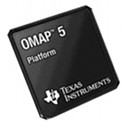 First announced last year, TI's OMAP5430 and OMAP5432 will offer dual 2GHz cores, support for up to four cameras, HD video encode/decode in 2D or 3D, imaging up to 24 megapixels, and Kinect-like gesture support. The 28nm-fabricated chips are based on the Cortex-A15 core announced by ARM in 2010 (see later in this story for background).
First announced last year, TI's OMAP5430 and OMAP5432 will offer dual 2GHz cores, support for up to four cameras, HD video encode/decode in 2D or 3D, imaging up to 24 megapixels, and Kinect-like gesture support. The 28nm-fabricated chips are based on the Cortex-A15 core announced by ARM in 2010 (see later in this story for background).
In addition to the two Cortex-A15 cores — each capable of being clocked at up to 2GHz — the OMAP 5 chips add individual, dedicated engines for video, imaging and vision, DSP, 3D graphics, 2D graphics, display, and security, says TI. The devices also include two ARM Cortex-M4 processors apiece, "for offloading real-time processing from the Cortex-A15 cores to improve low-level control and responsiveness of mobile devices."
TI said last February that the OMAP 5 chips would begin sampling during the second half of 2012, and we guess that schedule slipped a mite. According to a Jan. 12 AnandTech report from CES, the "chip just came back from the fab earlier this month and it's already up and running."
Author Anand Lal Shimpi reports seeing the OMAP 5 reference platform in operation, adding that he wasn't allowed to take photos. Engadget's Darren Murph saw it too, however, and was able to capture an image, as you can see below.

TI's OMAP 5 reference platform
Source: Engadget
According to Murph, the OMAP 5 made its debut — presumably in its OMAP5430 version — in this TI-created smartphone reference platform: "We saw quite a bit of swiping through Android 4.0.1, and as you'd expect, everything looked decidedly snappy. 720p video at 30 frames per second is no real chore, with the platform capable of pushing 1080p material at 64 frames per second."
Remi El-Ouazzane, vice president of TI's OMAP platform business unit, is quoted as saying that the OMAP 5 chips will be the first Cortex-A15 products on the market. (Samsung might disagree, since it has claimed that its similarly endowed Exynos 5250 is already sampling and will enter production by the middle of this year.)
TI adds that clock speed for clock speed, Cortex-A15 chips offer twice the performance of those based on the earlier Cortex-A9 core. "We are also running Windows 8 on the latest OMAP; it runs perfectly well, and we've been working very closely with Microsoft," El-Ouazzane is said to have added.
The CES demo of TI's OMAP 5
Source: Engadget
(click to play)
Background on the OMAP 5 …
The OMAP5430 and OMAP5432 are touted as providing "PC-like computing performance," but in fact appear to go beyond what's expected of most desktops today. For example, TI claims both OMAP 5 chips can support multiple cameras in parallel, recording and playing back either 1080p60 video in 2D or 1080p30 video in stereoscopic 3D. The devices also do real-time conversion of 2D 1080p content to 3D, says the company.
TI adds that the OMAP 5 chips will support advanced short- and long-range gesturing applications, as well as full-body and multi-body interactive gestures, utilizing either 2D or 3D cameras. Coupled with a TI DLP pico projector and a camera, they'll enable interactive projection, wherein the user can actually "touch and drag" projected images on both a tabletop or wall.
While specific power consumption figures haven't been released, as far as we're aware, TI says the OMAP 5 processors will "provide a nearly 60 percent average power reduction compared to a sample user experience on the OMAP 4 [link] platform." Compared to these earlier Cortex-A9 devices, the OMAP 5 devices will deliver up to three times the processing performance and five times the 3D graphics performance.
Differences between the OMAP5430 and OMAP5432 ports are detailed in the table below, but briefly: TI says the former is a smaller (14 x 14mm) device designed for smartphones, with support for LPDDR2 memory. The '30 supports up to four simultaneous displays and imaging up to 24 megapixels, the company adds.
The OMAP5432 is for "more cost-sensitive products," is a larger 17 x 17mm, and supports DDR3 memory, according to TI. The '32 supports three simultaneous displays, imaging up to 20 megapixels, and supports fewer peripherals than the '30, as the table indicates.
| OMAP5430 | OMAP5432 | |
| Target markets | area-sensitive (smartphones, tablets) | cost-sensitive (mobile computing, consumer) |
| Process node | 28 nanometer low-power process | |
| ARM Cortex-A15 clock speed (two) | up to 2 GHz | |
| 2D & 3D graphics | multi-core, hardware accelerated | |
| Video performance (2D) | 1080p60 multistandard | |
| Video performance (3D) | 1080p30 multistandard | |
| Imaging performance | Up to 24 MP (MIPI CSI-3+ 3x MIPI® CSI-2+ CPI interfaces) |
Up to 20MP (3x CSI-2+ CPI interfaces) |
| Memory support | 2 x LPDDR2 | 2 x DDR3/DDR3L |
| Peripheral support | UART (6x), HSIC (3x), SPI (4x), MIPI UniPort-M, MIPI LLI, HSI (2x) |
UART (5x), HSIC (2x), SPI (3x) |
| Package | 14mm x 14mm PoP 980 balls 0.4mm pitch (240-ball, 0.5mm PoP) I/F) |
17mm x 17mm BGA 754 balls 0.5mm pitch (w/depop) |
A comparison of the OMAP5430 and OMAP5432
Source: TI
According to TI, both the devices will allow for HDMI 1.4a outputs, MMC/SD slots, and USB 3.0 On-The-Go ports. They'll utilize Imagination Technologies Powervr SGX544 GPU (graphics processing unit) IP, which is said to provide full support for DirectX 9 Feature Level 3, desktop OpenGL 2.1, and other standards.
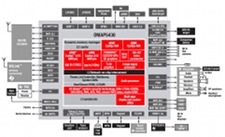
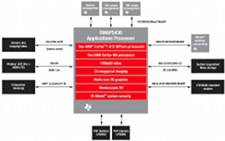
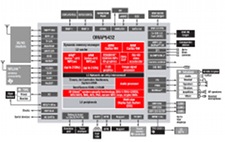
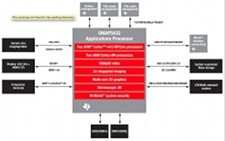
Chip (left) and application (right) block diagrams for the OMAP5430 (top row; chip (left) and application (right) block diagrams for the OMAP5432 (bottom row)
(Click any to enlarge)
… and more about ARM's Cortex-A15
Eager-beaver TI touted itself as "the first licensee of the next-generation ARM Cortex-A series processor core" even before the Cortex-A15 was formally announced. And certainly, there's a lot to like here.
For example, the Cortex-A15 MPCore processor is equipped with an out-of-order superscalar pipeline, along with a tightly-coupled low-latency level-2 cache of up to 4MB, according to ARM. The processor can decode and dispatch up to three instructions per cycle, says the company. This is said to be three times the rate possible with an ARM11 processor.
In addition, the Cortex-A15 can issue up to eight instructions per cycle, and take less than 10 microseconds to move into standby or wake up again. Floating point and NEON instruction set performance for signal processing and multimedia have also been improved, says ARM.
Compared to the Cortex-A9, the Cortex-A15 adds more efficient hardware support for operating system (OS) virtualization, soft-error recovery, larger memory addressability, and system coherency, says ARM. Large Physical Address Extensions (LPAE), shown in the diagram below, is said to permit addressing up to 1TB of memory.
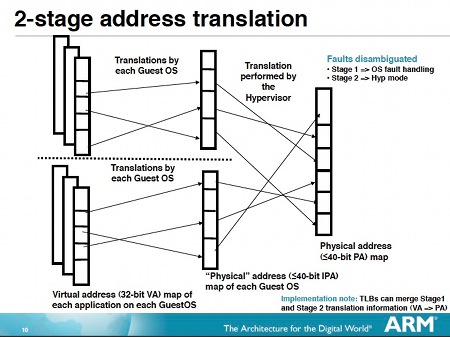
LPAE will let ARM Cortex-A15 CPUs work with physical memory up to 1TB
(Click to enlarge)
The Cortex-A15 is claimed to be the first ARM processor to incorporate highly efficient hardware support for data management and arbitration. This hypervisor support enables multiple virtual software environments and their applications to simultaneously access system capabilities while remaining isolated from each other, says the company. (For more details on some of the virtualization-oriented features in the ARMv7 extensions, see our earlier coverage here.)
Like the Cortex-A8 and Cortex-A9, the Cortex-A15 is based on ARMv7-A architecture, and offers instruction sets including Thumb-2, TrustZone, and NEON. Up to four symmetric multiprocessing (SMP) cores can be supported with a single processor cluster, and multiple coherent SMP clusters can be tied together via ARM's AMBA 4 interconnect technology, says ARM.
The Cortex-A15 is said to offer full application compatibility with all other Cortex-A processors, thereby enabling access to software including Android, Linux (including Ubuntu), Windows Embedded Compact 7, and Symbian operating systems. Compatibility was also cited last year for Adobe Flash Player, Java Platform Standard Edition (Java SE), and JavaFX, among other applications.
Further information
According to TI, OMAP 5-based devices are expected to go on sale at the end of this year or in early 2013. Further information may be found on the company's OMAP5430 product page and OMAP5432 product page.
Jonathan Angel can be reached at [email protected] and followed at www.twitter.com/gadgetsense.
This article was originally published on LinuxDevices.com and has been donated to the open source community by QuinStreet Inc. Please visit LinuxToday.com for up-to-date news and articles about Linux and open source.